英语语法试讲教案模板.doc
- 格式:doc
- 大小:132.51 KB
- 文档页数:21
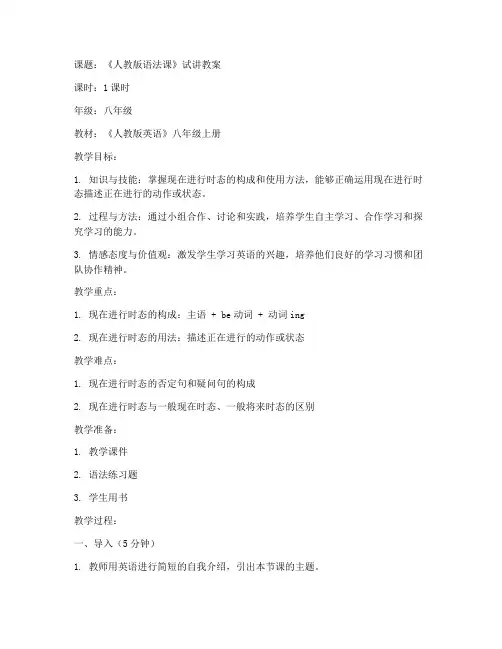
课题:《人教版语法课》试讲教案课时:1课时年级:八年级教材:《人教版英语》八年级上册教学目标:1. 知识与技能:掌握现在进行时态的构成和使用方法,能够正确运用现在进行时态描述正在进行的动作或状态。
2. 过程与方法:通过小组合作、讨论和实践,培养学生自主学习、合作学习和探究学习的能力。
3. 情感态度与价值观:激发学生学习英语的兴趣,培养他们良好的学习习惯和团队协作精神。
教学重点:1. 现在进行时态的构成:主语 + be动词 + 动词ing2. 现在进行时态的用法:描述正在进行的动作或状态教学难点:1. 现在进行时态的否定句和疑问句的构成2. 现在进行时态与一般现在时态、一般将来时态的区别教学准备:1. 教学课件2. 语法练习题3. 学生用书教学过程:一、导入(5分钟)1. 教师用英语进行简短的自我介绍,引出本节课的主题。
2. 提问学生:“What are you doing now?”(你现在在做什么?)让学生用一般现在时态回答。
二、新课讲授(20分钟)1. 介绍现在进行时态的构成:主语 + be动词(am/is/are)+ 动词ing。
2. 通过图片、视频等多媒体手段展示现在进行时态的用法。
3. 举例说明现在进行时态的肯定句、否定句和疑问句的构成。
4. 学生跟读例句,教师纠正发音。
三、小组活动(15分钟)1. 分组讨论:让学生用现在进行时态描述自己的日常生活。
2. 小组内互相纠正语法错误,互相学习。
3. 各小组派代表分享本组的讨论成果。
四、练习巩固(10分钟)1. 教师发放语法练习题,让学生独立完成。
2. 教师巡视课堂,指导学生解题。
3. 学生展示答案,教师点评。
五、总结与作业(5分钟)1. 教师对本节课所学内容进行总结,强调现在进行时态的构成和用法。
2. 布置课后作业:让学生用现在进行时态写一篇短文,描述周末的打算。
教学反思:1. 本节课通过多种教学方法,如图片、视频、小组讨论等,激发学生的学习兴趣,提高他们的英语学习积极性。
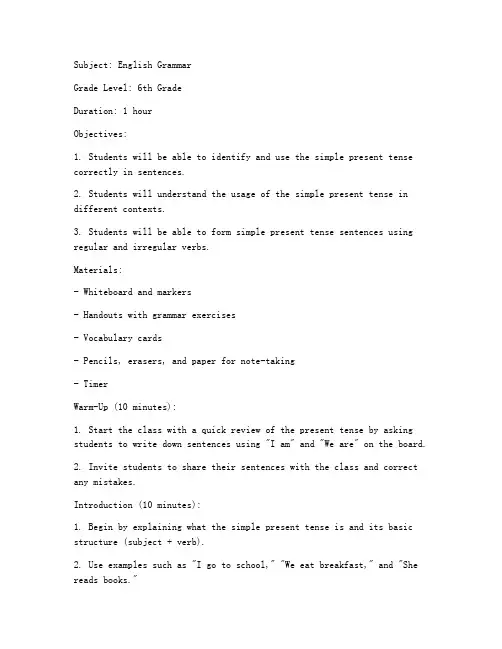
Subject: English GrammarGrade Level: 6th GradeDuration: 1 hourObjectives:1. Students will be able to identify and use the simple present tense correctly in sentences.2. Students will understand the usage of the simple present tense in different contexts.3. Students will be able to form simple present tense sentences using regular and irregular verbs.Materials:- Whiteboard and markers- Handouts with grammar exercises- Vocabulary cards- Pencils, erasers, and paper for note-taking- TimerWarm-Up (10 minutes):1. Start the class with a quick review of the present tense by asking students to write down sentences using "I am" and "We are" on the board.2. Invite students to share their sentences with the class and correct any mistakes.Introduction (10 minutes):1. Begin by explaining what the simple present tense is and its basic structure (subject + verb).2. Use examples such as "I go to school," "We eat breakfast," and "She reads books."3. Point out that the simple present tense is used to describe habits, general truths, and unchanging situations.Vocabulary and Usage (15 minutes):1. Introduce vocabulary related to the simple present tense, such as "always," "often," "sometimes," "never," and "usually."2. Use these adverbs to form sentences with the simple present tense,e.g., "I always do my homework," "We usually have English class on Monday."3. Discuss the difference between "always" and "often," emphasizing that "always" is used for regular, consistent actions, while "often"indicates frequency but not necessarily regularity.Grammar Exercises (20 minutes):1. Distribute handouts with a variety of exercises to practice forming simple present tense sentences.2. Exercises may include:- Fill in the blanks with the correct form of the verb.- Choose the correct verb form to complete the sentence.- Write sentences using the simple present tense with given vocabulary words.3. Circulate around the classroom to assist students and correct any mistakes.Interactive Activity (10 minutes):1. Divide the class into small groups.2. Each group is given a scenario, such as "A family is planning a vacation" or "A student is describing their favorite hobbies."3. Students must use the simple present tense to create a short dialogue or story based on their scenario.Review and Practice (10 minutes):1. Go over the key points of the lesson, emphasizing the rules for forming simple present tense sentences with regular and irregular verbs.2. Have students practice forming sentences with new vocabulary words from the handouts.Homework Assignment:1. Assign a short writing exercise where students describe their daily routine using the simple present tense.2. Encourage them to use at least three different adverbs of frequency.Conclusion:1. Summarize the main points of the lesson and reinforce the importance of using the simple present tense accurately.2. Open the floor for any questions or clarifications from students.3. Thank the students for their participation and encourage them to practice the simple present tense in their daily language use.Assessment:- Monitor students' participation in class activities and exercises.- Evaluate the quality of their homework assignments.- Conduct a short quiz at the end of the lesson to assess their understanding of the simple present tense.。
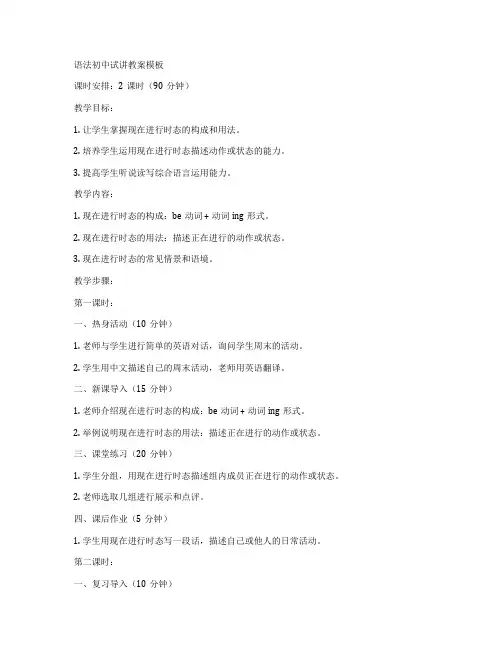
语法初中试讲教案模板课时安排:2课时(90分钟)教学目标:1. 让学生掌握现在进行时态的构成和用法。
2. 培养学生运用现在进行时态描述动作或状态的能力。
3. 提高学生听说读写综合语言运用能力。
教学内容:1. 现在进行时态的构成:be动词 + 动词ing形式。
2. 现在进行时态的用法:描述正在进行的动作或状态。
3. 现在进行时态的常见情景和语境。
教学步骤:第一课时:一、热身活动(10分钟)1. 老师与学生进行简单的英语对话,询问学生周末的活动。
2. 学生用中文描述自己的周末活动,老师用英语翻译。
二、新课导入(15分钟)1. 老师介绍现在进行时态的构成:be动词 + 动词ing形式。
2. 举例说明现在进行时态的用法:描述正在进行的动作或状态。
三、课堂练习(20分钟)1. 学生分组,用现在进行时态描述组内成员正在进行的动作或状态。
2. 老师选取几组进行展示和点评。
四、课后作业(5分钟)1. 学生用现在进行时态写一段话,描述自己或他人的日常活动。
第二课时:一、复习导入(10分钟)1. 老师提问学生,复习上节课所学的现在进行时态。
2. 学生展示课后作业,老师进行点评。
二、课堂讲解(15分钟)1. 老师讲解现在进行时态的常见情景和语境。
2. 举例说明现在进行时态在实际交际中的应用。
三、课堂练习(20分钟)1. 学生进行角色扮演,用现在进行时态模拟实际场景。
2. 老师选取几组进行展示和点评。
四、总结与拓展(10分钟)1. 老师对本节课的内容进行总结。
2. 学生提问,老师解答。
3. 老师给出一些建议,帮助学生更好地运用现在进行时态。
教学评价:1. 课后收集学生的课后作业,评估他们对现在进行时态的掌握程度。
2. 在下一节课开始时,老师可以提问学生关于现在进行时态的问题,以检验他们的记忆和理解。
以上教案模板可以根据具体情况进行调整和修改,以适应不同学生的学习需求。
希望对您的教学有所帮助!。
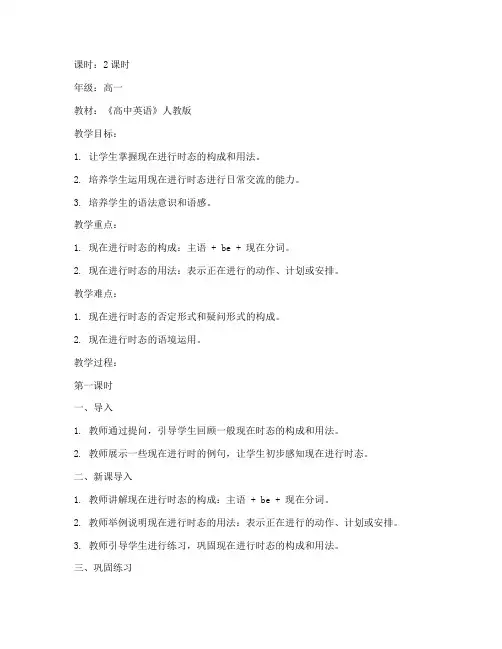
课时:2课时年级:高一教材:《高中英语》人教版教学目标:1. 让学生掌握现在进行时态的构成和用法。
2. 培养学生运用现在进行时态进行日常交流的能力。
3. 培养学生的语法意识和语感。
教学重点:1. 现在进行时态的构成:主语 + be + 现在分词。
2. 现在进行时态的用法:表示正在进行的动作、计划或安排。
教学难点:1. 现在进行时态的否定形式和疑问形式的构成。
2. 现在进行时态的语境运用。
教学过程:第一课时一、导入1. 教师通过提问,引导学生回顾一般现在时态的构成和用法。
2. 教师展示一些现在进行时的例句,让学生初步感知现在进行时态。
二、新课导入1. 教师讲解现在进行时态的构成:主语 + be + 现在分词。
2. 教师举例说明现在进行时态的用法:表示正在进行的动作、计划或安排。
3. 教师引导学生进行练习,巩固现在进行时态的构成和用法。
三、巩固练习1. 教师给出一些句子,让学生判断句子中的时态。
2. 教师给出一些句子,让学生将一般现在时态改为现在进行时态。
3. 教师给出一些句子,让学生将现在进行时态改为一般现在时态。
四、课堂小结1. 教师总结现在进行时态的构成和用法。
2. 学生分享学习心得。
第二课时一、复习1. 教师提问,检查学生对现在进行时态的掌握情况。
2. 学生回答问题,教师点评。
二、新课导入1. 教师讲解现在进行时态的否定形式和疑问形式的构成。
2. 教师举例说明现在进行时态的否定形式和疑问形式的用法。
三、巩固练习1. 教师给出一些句子,让学生判断句子中的时态。
2. 教师给出一些句子,让学生将一般现在时态改为现在进行时态的否定形式或疑问形式。
3. 教师给出一些句子,让学生将现在进行时态改为一般现在时态的否定形式或疑问形式。
四、课堂小结1. 教师总结现在进行时态的构成、用法、否定形式和疑问形式的构成。
2. 学生分享学习心得。
教学反思:1. 教师在教学过程中,注重引导学生进行实践,提高学生的语法意识和语感。
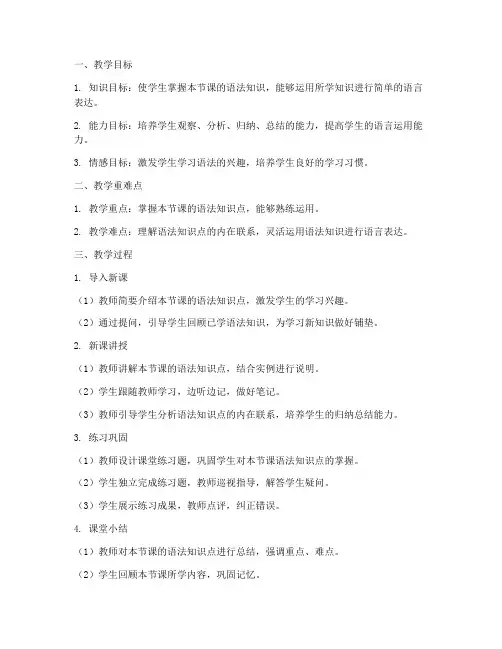
一、教学目标1. 知识目标:使学生掌握本节课的语法知识,能够运用所学知识进行简单的语言表达。
2. 能力目标:培养学生观察、分析、归纳、总结的能力,提高学生的语言运用能力。
3. 情感目标:激发学生学习语法的兴趣,培养学生良好的学习习惯。
二、教学重难点1. 教学重点:掌握本节课的语法知识点,能够熟练运用。
2. 教学难点:理解语法知识点的内在联系,灵活运用语法知识进行语言表达。
三、教学过程1. 导入新课(1)教师简要介绍本节课的语法知识点,激发学生的学习兴趣。
(2)通过提问,引导学生回顾已学语法知识,为学习新知识做好铺垫。
2. 新课讲授(1)教师讲解本节课的语法知识点,结合实例进行说明。
(2)学生跟随教师学习,边听边记,做好笔记。
(3)教师引导学生分析语法知识点的内在联系,培养学生的归纳总结能力。
3. 练习巩固(1)教师设计课堂练习题,巩固学生对本节课语法知识点的掌握。
(2)学生独立完成练习题,教师巡视指导,解答学生疑问。
(3)学生展示练习成果,教师点评,纠正错误。
4. 课堂小结(1)教师对本节课的语法知识点进行总结,强调重点、难点。
(2)学生回顾本节课所学内容,巩固记忆。
5. 课后作业(1)布置与本节课语法知识点相关的课后作业,巩固所学知识。
(2)要求学生在规定时间内完成作业,并按时上交。
四、教学反思1. 教学过程中,关注学生的学习情况,及时调整教学策略。
2. 注重启发式教学,引导学生主动学习,提高学生的参与度。
3. 注重培养学生的语言运用能力,让学生在实际情境中运用所学知识。
4. 关注学生的学习兴趣,激发学生的学习热情,提高教学质量。
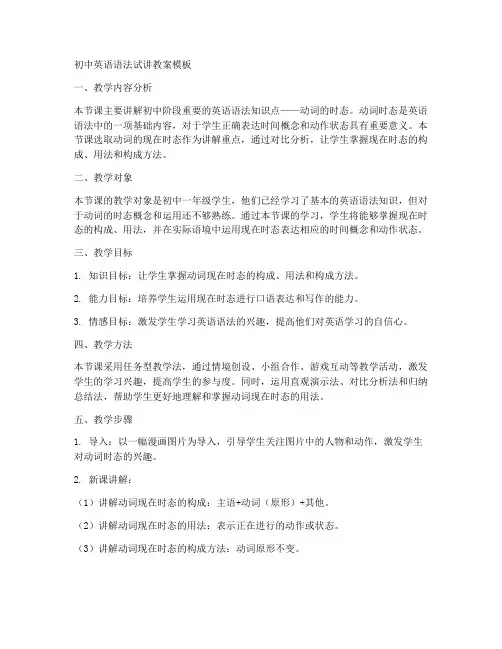
初中英语语法试讲教案模板一、教学内容分析本节课主要讲解初中阶段重要的英语语法知识点——动词的时态。
动词时态是英语语法中的一项基础内容,对于学生正确表达时间概念和动作状态具有重要意义。
本节课选取动词的现在时态作为讲解重点,通过对比分析,让学生掌握现在时态的构成、用法和构成方法。
二、教学对象本节课的教学对象是初中一年级学生,他们已经学习了基本的英语语法知识,但对于动词的时态概念和运用还不够熟练。
通过本节课的学习,学生将能够掌握现在时态的构成、用法,并在实际语境中运用现在时态表达相应的时间概念和动作状态。
三、教学目标1. 知识目标:让学生掌握动词现在时态的构成、用法和构成方法。
2. 能力目标:培养学生运用现在时态进行口语表达和写作的能力。
3. 情感目标:激发学生学习英语语法的兴趣,提高他们对英语学习的自信心。
四、教学方法本节课采用任务型教学法,通过情境创设、小组合作、游戏互动等教学活动,激发学生的学习兴趣,提高学生的参与度。
同时,运用直观演示法、对比分析法和归纳总结法,帮助学生更好地理解和掌握动词现在时态的用法。
五、教学步骤1. 导入:以一幅漫画图片为导入,引导学生关注图片中的人物和动作,激发学生对动词时态的兴趣。
2. 新课讲解:(1)讲解动词现在时态的构成:主语+动词(原形)+其他。
(2)讲解动词现在时态的用法:表示正在进行的动作或状态。
(3)讲解动词现在时态的构成方法:动词原形不变。
3. 实例分析:通过例句和练习,让学生对比分析现在时态和一般现在时的区别,加深学生对现在时态的理解。
4. 课堂练习:设计不同场景的练习题,让学生运用动词现在时态进行口语表达和写作。
5. 游戏互动:组织一个小组游戏,让学生在游戏中运用动词现在时态,增加课堂的趣味性。
6. 总结:对本节课的内容进行归纳总结,强调动词现在时态的构成、用法和构成方法。
7. 作业布置:布置相关的练习题,让学生巩固所学知识。
六、教学反思本节课结束后,教师应认真反思教学效果,针对学生的掌握情况,调整教学策略,以提高学生对动词现在时态的掌握程度。
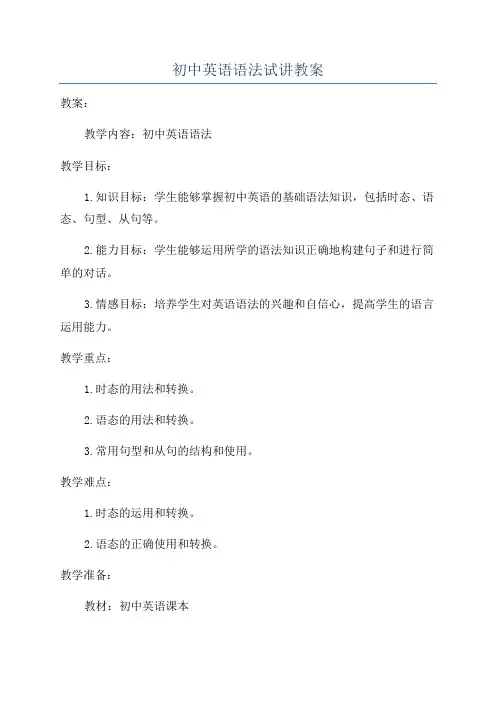
初中英语语法试讲教案教案:教学内容:初中英语语法教学目标:1.知识目标:学生能够掌握初中英语的基础语法知识,包括时态、语态、句型、从句等。
2.能力目标:学生能够运用所学的语法知识正确地构建句子和进行简单的对话。
3.情感目标:培养学生对英语语法的兴趣和自信心,提高学生的语言运用能力。
教学重点:1.时态的用法和转换。
2.语态的用法和转换。
3.常用句型和从句的结构和使用。
教学难点:1.时态的运用和转换。
2.语态的正确使用和转换。
教学准备:教材:初中英语课本教具:多媒体设备、教学演示素材:与时态、语态、句型相关的练习题、例句等。
教学过程:Step 1:导入新课1. GreetingT: Good morning, class!S: Good morning, teacher!T: How are you today?S: I'm fine, thank you. And you?T: I'm great, thank you! Are you ready for today's lesson?S: Yes, we are!2. RevisionT: Let's do a quick review. Can you tell me the past tense of the verb "run"?S: It's "ran".T: Good job! Now, what's the present perfect tense of the verb "eat"?S: It's "eaten".T: Excellent! You guys are doing great!Step 2:新知讲解1. Introduce the topic of grammar.T: Today, we are going to learn about grammar. Grammar is the structure or system of a language. It helps us to understand and use the language correctly. We will focus on tenses, voice, sentence patterns, and clauses. Let's get started!2. Present tensesa. Introduce the present simple tense.- Explain the usage and structure of present simple tense using examples.- Show the form of present simple tense: Subject + verb(s) + object.b. Introduce the present continuous tense.- Explain the usage and structure of present continuous tense using examples.- Show the form of present continuous tense: Subject + be verb (am/are/is) + verb-ing + object.3. Past tensesa. Introduce the past simple tense.- Explain the usage and structure of past simple tense using examples.- Show the form of past simple tense: Subject + past tense verb + object.b. Introduce the past continuous tense.- Explain the usage and structure of past continuous tense using examples.- Show the form of past continuous tense: Subject + past tense of be verb (was/were) + verb-ing + object.4. Future tensesa. Introduce the future simple tense.- Explain the usage and structure of future simple tense using examples.- Show the form of future simple tense: Subject + will + base form of verb + object.b. Introduce the future continuous tense.- Explain the usage and structure of future continuous tense using examples.- Show the form of future continuous tense: Subject + will be + verb-ing + object.5. Active and passive voicea. Introduce the active voice.- Explain the usage and structure of active voice using examples.- Show the form of active voice: Subject + verb + object.b. Introduce the passive voice.- Explain the usage and structure of passive voice using examples.- Show the form of passive voice: Object + be verb(am/are/is/was/were) + past participle (verb + ed) + by + subject.c. Practice exercises: Ask students to change the sentences from active voice to passive voice.Step 3:练习巩固1. Group work- Divide students into groups.- Monitor and assist students as they work.- Have groups share their answers and discuss any differences.2. Individual work- Students should work independently and submit their work when finished.- Review answers together as a class.Step 4:总结和回顾1. T: Now, let's summarize what we have learned today.- Review the different tenses, voice, sentence patterns, and clauses covered in the lesson.- Encourage students to ask any questions they may have.S: Goodbye, teacher! Thank you!。
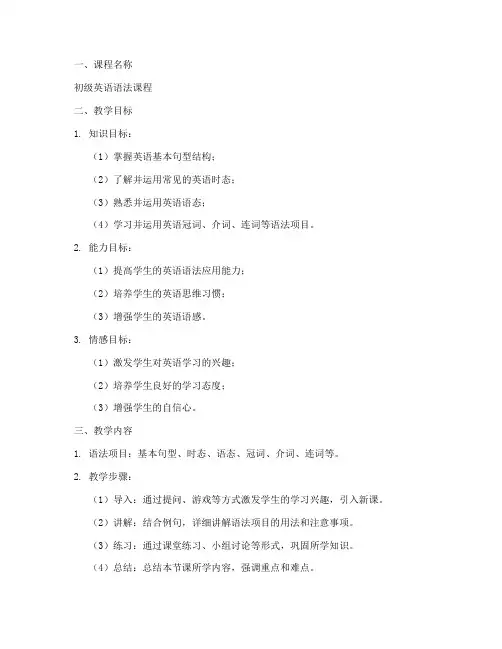
一、课程名称初级英语语法课程二、教学目标1. 知识目标:(1)掌握英语基本句型结构;(2)了解并运用常见的英语时态;(3)熟悉并运用英语语态;(4)学习并运用英语冠词、介词、连词等语法项目。
2. 能力目标:(1)提高学生的英语语法应用能力;(2)培养学生的英语思维习惯;(3)增强学生的英语语感。
3. 情感目标:(1)激发学生对英语学习的兴趣;(2)培养学生良好的学习态度;(3)增强学生的自信心。
三、教学内容1. 语法项目:基本句型、时态、语态、冠词、介词、连词等。
2. 教学步骤:(1)导入:通过提问、游戏等方式激发学生的学习兴趣,引入新课。
(2)讲解:结合例句,详细讲解语法项目的用法和注意事项。
(3)练习:通过课堂练习、小组讨论等形式,巩固所学知识。
(4)总结:总结本节课所学内容,强调重点和难点。
四、教学过程1. 导入- 提问:同学们,你们知道英语语法的重要性吗?- 游戏:猜词游戏,引导学生关注语法在语言表达中的作用。
2. 讲解- 基本句型:讲解简单句、并列句、复合句等句型结构。
- 时态:讲解现在时、过去时、将来时等时态的用法。
- 语态:讲解主动语态和被动语态的区别及用法。
- 冠词:讲解不定冠词、定冠词、零冠词的用法。
- 介词:讲解常用介词的用法和搭配。
- 连词:讲解并列连词和从属连词的用法。
3. 练习- 课堂练习:完成语法填空、改错等练习题。
- 小组讨论:分组讨论语法问题,互相纠正错误。
4. 总结- 强调本节课所学重点和难点。
- 鼓励学生在课后复习,巩固所学知识。
五、教学评价1. 课堂表现:观察学生在课堂上的参与度、发言积极性等。
2. 课后作业:检查学生的课后练习情况,了解学生对语法知识的掌握程度。
3. 课堂测试:进行小测验,检验学生对语法知识的掌握情况。
六、教学反思1. 课后反思:总结本节课的教学效果,分析不足之处,为今后的教学提供改进方向。
2. 学生反馈:收集学生对课程的意见和建议,不断优化教学内容和方法。
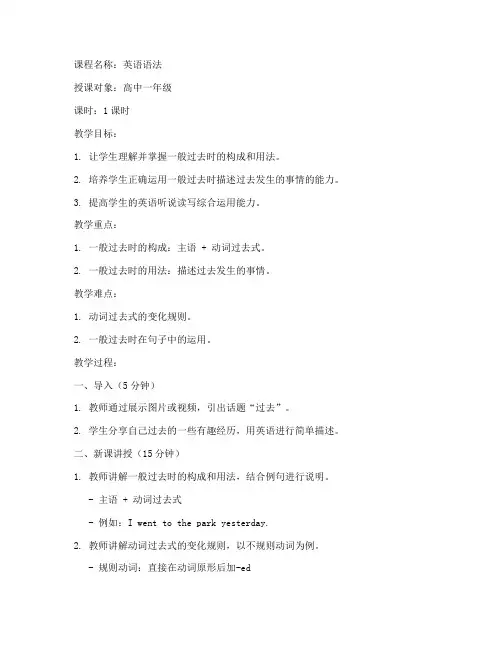
课程名称:英语语法授课对象:高中一年级课时:1课时教学目标:1. 让学生理解并掌握一般过去时的构成和用法。
2. 培养学生正确运用一般过去时描述过去发生的事情的能力。
3. 提高学生的英语听说读写综合运用能力。
教学重点:1. 一般过去时的构成:主语 + 动词过去式。
2. 一般过去时的用法:描述过去发生的事情。
教学难点:1. 动词过去式的变化规则。
2. 一般过去时在句子中的运用。
教学过程:一、导入(5分钟)1. 教师通过展示图片或视频,引出话题“过去”。
2. 学生分享自己过去的一些有趣经历,用英语进行简单描述。
二、新课讲授(15分钟)1. 教师讲解一般过去时的构成和用法,结合例句进行说明。
- 主语 + 动词过去式- 例如:I went to the park yesterday.2. 教师讲解动词过去式的变化规则,以不规则动词为例。
- 规则动词:直接在动词原形后加-ed- 不规则动词:需记忆特殊变化形式3. 教师展示一般过去时的句子,让学生判断正误。
- 例如:She is eating apples.(×)She ate apples.(√)三、巩固练习(15分钟)1. 学生完成课后练习题,巩固一般过去时的用法。
2. 教师挑选部分练习题进行讲解,纠正学生的错误。
四、课堂小结(5分钟)1. 教师总结本节课的学习内容,强调一般过去时的构成和用法。
2. 学生回顾本节课的重点内容,提出疑问。
五、课后作业(5分钟)1. 完成课后练习题。
2. 用一般过去时描述自己过去的一件有趣事情。
教学反思:1. 本节课通过图片、视频等多种教学手段,激发学生的学习兴趣。
2. 注重培养学生的英语听说读写综合运用能力,提高学生的英语水平。
3. 在讲解一般过去时变化规则时,应注重培养学生的记忆能力,提高学习效率。
微课设计:1. 使用PPT展示教学内容,图文并茂,便于学生理解。
2. 添加动画效果,提高课堂趣味性。
3. 针对不同知识点,设计练习题,检验学生的学习效果。
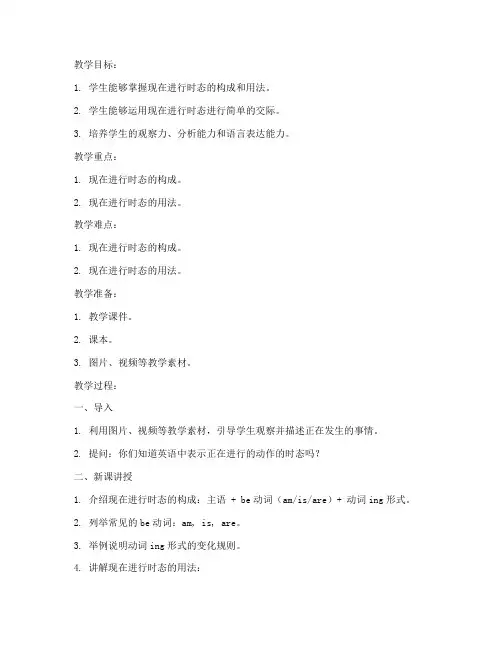
教学目标:1. 学生能够掌握现在进行时态的构成和用法。
2. 学生能够运用现在进行时态进行简单的交际。
3. 培养学生的观察力、分析能力和语言表达能力。
教学重点:1. 现在进行时态的构成。
2. 现在进行时态的用法。
教学难点:1. 现在进行时态的构成。
2. 现在进行时态的用法。
教学准备:1. 教学课件。
2. 课本。
3. 图片、视频等教学素材。
教学过程:一、导入1. 利用图片、视频等教学素材,引导学生观察并描述正在发生的事情。
2. 提问:你们知道英语中表示正在进行的动作的时态吗?二、新课讲授1. 介绍现在进行时态的构成:主语 + be动词(am/is/are)+ 动词ing形式。
2. 列举常见的be动词:am, is, are。
3. 举例说明动词ing形式的变化规则。
4. 讲解现在进行时态的用法:a. 表示正在进行的动作。
b. 表示正在发生的动作。
c. 表示按计划或安排即将发生的动作。
三、课堂练习1. 完成课本上的练习题,巩固所学知识。
2. 根据所学内容,用现在进行时态描述以下场景:a. 在教室里。
b. 在公园里。
c. 在电影院里。
四、小组讨论1. 将学生分成小组,讨论以下问题:a. 现在进行时态与一般现在时态的区别。
b. 现在进行时态在日常生活中的应用。
2. 每组选派一名代表进行发言。
五、总结1. 回顾本节课所学内容,强调现在进行时态的构成和用法。
2. 布置课后作业,巩固所学知识。
教学反思:本节课通过图片、视频等教学素材,激发学生的学习兴趣,让学生在轻松愉快的氛围中学习现在进行时态。
在课堂练习和小组讨论环节,学生积极参与,提高了他们的观察力、分析能力和语言表达能力。
在教学过程中,应注意以下几点:1. 注重学生的主体地位,鼓励学生主动参与课堂活动。
2. 结合实际生活,引导学生运用所学知识进行交际。
3. 及时发现学生的学习困难,给予针对性的指导。
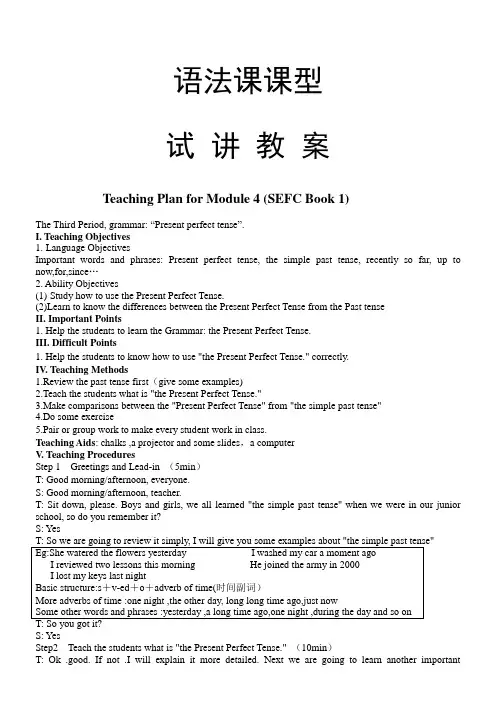
语法课课型试讲教案Teaching Plan for Module 4 (SEFC Book 1)The Third Period, grammar:“Present perfect tense”.I. Teaching Objectivesnguage ObjectivesImportant words and phrases: Present perfect tense, the simple past tense, recently so far, up to now,for,since…2. Ability Objectives(1)Study how to use the Present Perfect Tense.(2)Learn to know the differences between the Present Perfect Tense from the Past tenseII. Important Points1. Help the students to learn the Grammar: the Present Perfect Tense.III. Difficult Points1. Help the students to know how to use "the Present Perfect Tense." correctly.IV. Teaching Methods1.Review the past tense first(give some examples)2.Teach the students what is "the Present Perfect Tense."3.Make comparisons between the "Present Perfect Tense" from "the simple past tense"4.Do some exercise5.Pair or group work to make every student work in class.Teaching Aids: chalks ,a projector and some slides,a computerV. Teaching ProceduresStep 1 Greetings and Lead-in (5min)T: Good morning/afternoon, everyone.S: Good morning/afternoon, teacher.T: Sit down, please. Boys and girls, we all learned "the simple past tense" when we were in our junior school, so do you remember it?S: YesT: So we are going to review it simply, I will give you some examples about "the simple past tense" Eg:She watered the flowers yesterday I washed my car a moment agoI reviewed two lessons this morning He joined the army in 2000I lost my keys last nightBasic structure:s+v-ed+o+adverb of time(时间副词)More adverbs of time :one night ,the other day, long long time ago,just nowSome other words and phrases :yesterday ,a long time ago,one night ,during the day and so onS: YesStep2 Teach the students what is "the Present Perfect Tense."(10min)grammar--the Present Perfect Tense (analysis sentences)I have spent all of my money He already finished his homeworkHe has been ill for a long time She has lived in Beijing for 10 yearsHave you had your lunch?more words and phrases:so far,ever,up to now ,just,recently,yet,before and so on.T: Who can tell me what tense I used in the sentences?S: I can. It is the Present Perfect Tense.T: Right. Let’s look at these sentences.(Show them on the screen.)1. I’ve seen quite a lot of China.2. I’ve visited some beautiful cities.3. He’s just completed it.4. They’ve put up a lot of high-rise buildings recently.5. A friend has told me about a nice little fish restaurant here.6. It has been six years since we last saw each other, you know.(First, get the students to discuss and compare these sentences. Then the teacher discuss with them.)T: Let’s look at the first sentence. Do we know when the speaker saw these places?S: No, we don’t.T: Right. The second. Do we know when the speaker visited these cities?S: No, we don’t.T: Good. The third one. Is this a recent event?S: Yes, it is.T: The fourth. Did they do this a long time ago?S: No, they didn’t.T: The fifth. Did this happen recently?S: Yes, it did.T: Very good. The last one. When was the last time that the speaker saw his friend?S: 6 years ago.T: Wonderful! Now we know when we can use the Present Perfect Tense.(If necessary, give more examples and explanations.)for and sincefor+时间段eg:I have lived in this city for more than 40 years I have waited for you for two hourssince+时间点/过去时的句子It is/has been +时间段+since+时间点/过去时的句子He has been here since 1998 It is five years since he got marriedStep III Excises (10min)Complete these sentences with the words in the box use either the past simple tense or the present perfect tense.built buy come get live see stay visit1. They _________ many high-rise buildings in the city.2. The traffic in the city_________ much worse recently.3. When the tourists _________ in the summer, they _________ in the city center.4. Xiamen is one of the most attractive cities John_________.5. Xiao Li _________ in Xiamen all his life.6. John _________ (not) any presents yet but he _________ a shopping mall, where they will go tomorrow.(Ask the students to answer the questions, first individually, then compare their answers in pairs andcheck the answers with the whole class.)Suggested answers:1.have built2.has got3.came,stayed4.has visited5.has lived6.has not bought, has seenPracticeT: Now please write down some interesting places that you have been to. Work in pairs and tell each other about the places. Requirement:your contents must include" the present perfect tense" and" the past simple tense"Possible answer:A: I have been to Shanghai, Tianjin, Dalian, Nanjing and Xuzhou.B: When did you go to Dalian?A: I went there last year.B: What was it like?A: It’s very beautiful. Have you been there?B: No, I haven’t.Step V Summary (5min)this class we have learned something important about " the Present Perfect Tense".such as it's usage and basic structure.we also know the differences about "the Present Perfect Tense"and the Past Tense" what's more,we should pay more attention to the words"for" and "since"Step VI Homework Assignment(2min).review what we learned this class and finish the exercises on your workbookpreview the grammar 2 on your textbook page 36VI. Blackboard Design(1) Important words and phrases: the simple past tense the Present Perfect Tense .recently so far, up to now...(2) Important sentence patterns:for+时间段1It is/has been +时间段+since+时间点/过去时的句子Lesson 4, Unit 1A Social Survey—My Neighborhood(The Third Period: “Present perfecttense”)1. Review the simple tense simply2.Introduce and teach the PresentPerfect Tense3. Compare the simple tense and thePresent Perfect Tense4 .Excises5. Simple summaryHomework:.review what welearned this class andfinish the exerciseson your workbookpreview the grammar 2on your textbook page36。
一、教学目标1. 知识目标:使学生掌握语法知识,提高语法运用能力。
2. 能力目标:培养学生分析、理解、运用语法知识的能力。
3. 情感目标:激发学生对英语学习的兴趣,提高学生的自信心。
二、教学重难点1. 教学重点:本节课所教授的语法知识。
2. 教学难点:语法知识的运用及与实际语境的结合。
三、教学过程1. 导入新课(1)通过提问、游戏、歌曲等形式,激发学生对本节课的兴趣。
(2)简要回顾上一节课所学内容,为引入新课做好铺垫。
2. 新课讲授(1)讲解本节课所教授的语法知识,包括定义、用法、例句等。
(2)结合实际语境,讲解语法知识在实际句子中的应用。
(3)通过多媒体展示,让学生直观地了解语法知识。
3. 练习巩固(1)设计各种形式的练习题,让学生在练习中巩固所学知识。
(2)鼓励学生积极参与,展示自己的学习成果。
(3)教师巡视指导,及时解答学生疑问。
4. 拓展延伸(1)引入与新课相关的课外知识,拓宽学生视野。
(2)鼓励学生运用所学知识进行创新,提高英语实际运用能力。
5. 总结归纳(1)对本节课所学内容进行总结,让学生回顾所学知识。
(2)强调语法知识的重要性,鼓励学生在日常生活中多加运用。
四、教学评价1. 课堂表现:观察学生在课堂上的学习态度、参与程度等。
2. 作业完成情况:检查学生对课堂所学知识的掌握程度。
3. 课堂练习:评估学生在课堂练习中的表现。
五、教学反思1. 教学过程中,关注学生的学习需求,调整教学策略。
2. 鼓励学生积极参与,提高课堂氛围。
3. 及时反馈,关注学生进步,激发学习兴趣。
以下为具体教案示例:教案名称:高中英语语法《现在进行时》一、教学目标1. 知识目标:使学生掌握现在进行时的构成、用法及意义。
2. 能力目标:培养学生运用现在进行时描述正在发生的动作的能力。
3. 情感目标:激发学生对英语学习的兴趣,提高学生的自信心。
二、教学重难点1. 教学重点:现在进行时的构成、用法及意义。
2. 教学难点:现在进行时在句子中的运用及与一般现在时的区别。
课程名称:高中英语语法授课对象:高中一年级学生课时安排: 1课时教学目标:1. 知识目标:掌握所讲语法点的概念、用法及典型例句。
2. 能力目标:提高学生运用所学语法知识进行交际的能力。
3. 情感目标:激发学生学习英语的兴趣,培养学生良好的学习习惯。
教学重点:本节课所讲语法点的概念和用法。
教学难点:本节课所讲语法点的灵活运用。
教学准备:1. 教师准备:PPT课件、语法练习题、实物或图片等教学辅助材料。
2. 学生准备:预习所讲语法点,准备与语法点相关的例句。
教学过程:一、导入新课(5分钟)1. 利用图片、视频或实物导入,激发学生学习兴趣。
2. 提问:同学们,你们知道今天我们要学习什么语法点吗?简单介绍本节课所讲语法点。
二、讲解新课(25分钟)1. 讲解语法点的概念,结合例句进行分析。
2. 展示PPT课件,详细讲解语法点的用法,包括时态、语态、非谓语动词等。
3. 结合实物或图片,让学生进行实际操作,加深对语法点的理解。
三、课堂练习(15分钟)1. 分组练习,让学生运用所学语法点进行交际。
2. 教师巡视指导,纠正学生的错误。
四、课堂小结(5分钟)1. 回顾本节课所讲语法点,强调重点和难点。
2. 布置课后作业,巩固所学知识。
五、课后作业1. 完成课后练习题,巩固所学语法点。
2. 搜集与所学语法点相关的例句,进行积累。
教学反思:1. 本节课的教学效果如何?2. 学生对所讲语法点的掌握程度如何?3. 教学过程中有哪些不足之处?4. 如何改进教学方法,提高教学效果?板书设计:高中英语语法试讲教案模板课程名称:高中英语语法授课对象:高中一年级学生课时安排: 1课时教学目标:1. 知识目标:掌握所讲语法点的概念、用法及典型例句。
2. 能力目标:提高学生运用所学语法知识进行交际的能力。
3. 情感目标:激发学生学习英语的兴趣,培养学生良好的学习习惯。
教学重点:本节课所讲语法点的概念和用法。
教学难点:本节课所讲语法点的灵活运用。
课程名称:英语语法授课对象:中专一年级学生教学目标:1. 知识目标:使学生掌握特定的英语语法知识点,如时态、语态、非谓语动词等。
2. 能力目标:提高学生运用英语语法知识进行准确表达的能力。
3. 情感目标:培养学生对英语学习的兴趣,增强学习英语的自信心。
教学重点:1. 语法知识点的讲解与示范。
2. 语法知识的实际运用。
教学难点:1. 语法知识点的理解和运用。
2. 学生对复杂语法结构的掌握。
教学准备:1. 课件或黑板。
2. 练习题。
3. 教学案例。
教学过程:一、导入1. 通过与学生互动,复习上节课学过的语法知识点。
2. 引入本节课要学习的语法知识点,提出问题激发学生兴趣。
二、新课讲解1. 讲解语法知识点,结合具体例句进行说明。
2. 通过图片、视频等多媒体手段,直观展示语法知识。
3. 引导学生分析例句,总结语法规则。
三、课堂练习1. 进行语法填空练习,巩固学生对知识点的掌握。
2. 分组讨论,让学生运用所学语法知识进行造句。
3. 教师点评,纠正学生错误,强调语法要点。
四、案例分析1. 选取实际生活中的案例,让学生分析其中的语法结构。
2. 引导学生思考,提高运用语法知识解决实际问题的能力。
五、总结1. 回顾本节课所学的语法知识点,强调重点和难点。
2. 鼓励学生在课后进行复习和巩固。
六、布置作业1. 完成课后练习题,巩固所学知识。
2. 搜集生活中运用到所学生语法知识点的例子,进行分享。
教学反思:1. 教师在讲解过程中,要注意语言表达清晰,避免使用过于复杂的句子结构。
2. 针对不同层次的学生,要因材施教,适当调整教学内容和进度。
3. 鼓励学生积极参与课堂互动,提高学生的主动学习意识。
4. 关注学生的学习效果,及时调整教学方法,提高教学质量。
教学时间:1课时板书设计:一、导入1. 复习上节课语法知识点2. 引入本节课语法知识点二、新课讲解1. 语法知识点讲解2. 举例说明3. 多媒体展示三、课堂练习1. 语法填空练习2. 分组讨论3. 教师点评四、案例分析1. 选取实际案例2. 分析语法结构3. 提高运用能力五、总结1. 回顾知识点2. 强调重点和难点六、布置作业1. 完成课后练习题2. 搜集案例分享。
语法初中试讲教案一、教学目标1. 让学生掌握现在进行时态的构成和用法。
2. 培养学生运用现在进行时态描述动作或状态的能力。
3. 提高学生对英语语法的兴趣和积极性。
二、教学内容1. 现在进行时态的构成:be动词 + 动词ing形式。
2. 现在进行时态的用法:描述正在进行的动作或存在的状态。
3. 现在进行时态的肯定句、否定句和疑问句结构。
三、教学重点与难点1. 重点:现在进行时态的构成和用法。
2. 难点:现在进行时态的肯定句、否定句和疑问句结构的运用。
四、教学方法1. 情境教学法:通过设定情境,让学生在实际语境中感受和运用现在进行时态。
2. 任务型教学法:设计各种任务,让学生在完成任务的过程中练习和巩固现在进行时态。
3. 互动式教学法:鼓励学生积极参与,进行师生互动、生生互动。
五、教学步骤Step 1: 导入1. 利用图片展示正在进行的动作,如:running, reading, writing。
2. 引导学生说出这些动作的进行时态,即running, reading, writing。
Step 2: 讲解现在进行时态1. 讲解现在进行时态的构成:be动词 + 动词ing形式。
2. 讲解现在进行时态的用法:描述正在进行的动作或存在的状态。
Step 3: 练习现在进行时态1. 设计情境,如:教室里的学生正在做什么?2. 让学生用现在进行时态描述教室里的情景。
Step 4: 拓展现在进行时态1. 讲解现在进行时态的肯定句、否定句和疑问句结构。
2. 让学生举例并练习这些句型。
Step 5: 小组活动1. 学生分成小组,用现在进行时态编写对话。
2. 各小组展示对话,并进行评价。
Step 6: 总结与作业1. 总结现在进行时态的构成、用法和句型。
2. 布置作业:用现在进行时态写一篇小作文,描述自己正在做的事情。
六、教学反思本节课通过情境教学、任务型教学和互动式教学法,让学生在实际语境中感知、理解和运用现在进行时态。
课程名称:英语语法授课年级:八年级授课课时:1课时教学目标:1. 知识目标:学生能够掌握现在进行时态的构成和用法。
2. 能力目标:学生能够运用现在进行时态进行日常交流,描述正在进行的动作或活动。
3. 情感目标:培养学生对英语学习的兴趣,提高学生的语言运用能力。
教学重点:1. 现在进行时态的构成:be + 动词的现在分词形式。
2. 现在进行时态的用法:描述正在进行的动作或活动。
教学难点:1. 现在进行时态的构成和用法。
2. 在实际交流中正确运用现在进行时态。
教学准备:1. 多媒体课件2. 语法练习题3. 图片或视频素材教学过程:一、导入(5分钟)1. 通过提问或图片展示,引导学生回顾过去时态和一般现在时态的用法。
2. 提出本节课要学习的语法点:现在进行时态。
二、新课讲授(20分钟)1. 介绍现在进行时态的构成:be + 动词的现在分词形式。
2. 通过例句讲解现在进行时态的用法,如:- I am reading a book.- She is watching TV.- They are playing football.3. 展示一些现在进行时态的例句,让学生跟读并模仿。
4. 通过图片或视频展示不同的场景,让学生用现在进行时态描述正在发生的事情。
三、练习巩固(15分钟)1. 进行小组活动,让学生用现在进行时态描述图片或视频中的场景。
2. 进行语法填空练习,巩固现在进行时态的构成和用法。
3. 学生互相检查练习答案,教师进行点评和纠正。
四、课堂小结(5分钟)1. 总结本节课所学的现在进行时态的构成和用法。
2. 强调现在进行时态在实际交流中的重要性。
五、课后作业(5分钟)1. 完成课后练习题,巩固所学知识。
2. 用现在进行时态写一篇短文,描述自己正在做的事情。
教学反思:本节课通过多种教学方法,帮助学生掌握了现在进行时态的构成和用法。
在教学过程中,要注意以下几点:1. 注重学生的参与度,鼓励学生积极发言和互动。
课时:1课时年级:八年级教材:《英语》人教版教学目标:1. 让学生掌握现在进行时的构成和用法。
2. 培养学生运用现在进行时进行简单描述的能力。
3. 提高学生对英语语法的兴趣和自主学习能力。
教学重点:1. 现在进行时的构成:be动词+动词ing形式。
2. 现在进行时的用法:表示正在进行的动作或存在的状态。
教学难点:1. 现在进行时的时态转换。
2. 现在进行时与一般现在时的区别。
教学过程:一、导入1. 利用图片或视频,展示一些正在进行的动作或存在的状态,引导学生观察并思考。
2. 提问:这些动作或状态是如何用英语表达的?二、新课讲授1. 讲解现在进行时的构成:be动词+动词ing形式。
2. 举例说明现在进行时的用法,如:I am reading a book.(我正在读书。
)3. 讲解现在进行时的时态转换,如:过去进行时(was/were+动词ing形式)、将来进行时(will be+动词ing形式)。
4. 分析现在进行时与一般现在时的区别,如:一般现在时表示经常性、习惯性动作或存在的状态,现在进行时表示正在进行的动作或存在的状态。
三、练习1. 完成课本上的练习题,巩固所学知识。
2. 针对现在进行时的构成和用法,进行口头练习,如:用现在进行时描述图片中的场景。
3. 分组讨论,用现在进行时进行角色扮演,如:模拟餐厅服务员与顾客的对话。
四、总结1. 回顾本节课所学内容,强调现在进行时的构成和用法。
2. 提醒学生在日常生活中注意运用现在进行时,提高英语表达能力。
五、作业1. 完成课后练习题。
2. 用现在进行时描述自己的周末计划。
教学反思:1. 本节课通过图片、视频等多种教学手段,激发学生的学习兴趣,提高课堂效果。
2. 在讲解语法知识时,注重理论与实践相结合,让学生在实际运用中掌握语法规则。
3. 关注学生的学习差异,给予个别辅导,确保每个学生都能掌握所学知识。
英语语法试讲教案模板【篇一:教师资格证考试高中英语教案模板】1. teaching aims:1. train the students’ reading ability.2. enable the students to realize ...3. stimulate(激发)the students’ interest and ...2. teaching methods:1.fast reading to get general idea of the text.2.careful reading to understand the passage better.3. teaching procedures(程序):step1lead-inuse some pictures of ... to lead in the topic.step 2pre-reading1.play a guess game: ...2.play another guess game: ...step 3predict (预测)1. ask the students to predict what the reading passage talks about according to the title and illustrations (插图) of passage. the teacher can give some clues by talking about the illustrations:......step 4skimming(略读)1.let the students skim the whole passage to get the mainidea, then evaluate their predictions. during this activity, theteacher should give some guidance(指导)on reading skills. main idea of the passage:...2.let the students skim the passage and divide it into differentparts to find out the main idea of every part an the topic sentences.part 1 (paragraph 1...)......step 5careful reading... (问题)ask the students to scan the second part and completethe chart (图表) with information from the passage.ask the students to read carefully and finish the followingtasks:......(设计一些问题或判断对错等)knowledge aims1.to listen to and understand the listening materials.2.students can master the following expressions:...(一些句型)ability aims1.enable students to catch and understand the listening materials.2.develop students ’ ability to get special information and take note while listening.3.get students to learn and use the expressions of ... emotional aim1.enable students to know more about ...2. develop students’ sense of ...teaching proceduresstep 1lead-inplay a game ...1.put students into pairs. give them each two minutes to think of ......(游戏过程)step 2pre-listening1.tell students they will listen to a dialogue about ...2.give students some directions and make them predict what the listening text is about.step 3while-listening1.tell students listen to the tape first to get the main ideaand decide whether their prediction gist right or not.2.ask students to listen to the tape again. let them listen and answer some questions. (show the questions on the blackboard)3.students exchange the information and listen to the tape a third time for checking. let them have the correct answers. step 4post-listening1.give 2-3 minutes to students to ask questions if theyhave any.2.show students the listening text and let them read it aloud.3.let students read aloud the questions and expressionson the blackboard: ...(之前目标里的句型)4.make sure they will understand and enable to use the, then let them in pairs discuss ...5.get some pairs to act out their dialogue in front of the class. step 5homework1.make sentences with the expressions in the lesson.2.surf the internet to find out more information about ...3.给一篇文章用来讲语法的课堂设计knowledge objectivesto learn the use of ...(语法点)ability objectivesto use ... (语法) correctly and properly according to the context.emotional objectives1.to become interested in grammar learning.2.to develop the sense of group cooperationteaching important pointsget students to learn and master the new grammar item: ...(语法)teaching difficult pointsenable students to learn how to use ... correctly.teaching proceduresstep 1revision1.check the homework exercises.2.let students dictate some new words and expressions.step 2discovering useful structures1. ask students to read through the passage ... , pick out the sentences where ...(语法)are, and then underline ... (语法)2.let students work in pairs to translate these sentences andtry to understand the use of ...3.have students observe the sentences and drawthe conclusion: ...step 3understanding and summarizing1.ask students to work in pairs to finish the followingexercises on how ... are used. (show the following on thescreen)...step 4using structures(show the following exercises on the screen or give out exercises papers.) answer the following questions using ... ...1.ask students to work in group of four.2.give them four minutes to finish the work and askeach group to choose the best answers.3.ask students to choose the best sentences.step 5playing the gameget into groups and play the game:step 6closing down by a quiz.(show some exercises on the screen.)let students finish them within a few minutes, then check the answers with the whole class.knowledge objectivesby the end of this lesson the students:1.will have a better understanding of the structure and characteristics of an advertisement.2.will grasp some useful words and expressions to describea good restaurant such as: ...ability objectives1.to grasp the use of persuasive sentences.2.to improve the ability of in gathering, analyzing, comparing and making conclusion.moral objectives1. to improve the students’ learning motivation.2.to make the students become confident.3.to improve their ability of cooperating with each other through discussing. teaching important and difficult pointstask-based approach, cooperating approach and communicative approach. teaching proceduresstep 1revision lead infirst check the homework of last class.then let the students s homework with each other and discuss in groups of 4, take notes, find out and category the impressive sentences into 5 kinds of information: ...step 2discussing1.show students 4 pictures of ...2.ask 3 students to report their work, show them the pictures of ...step 3pre-writing1.show them the sample ...2.read the ... and think over what are the characteristics of ... , encourage some students to analyze and tell their opinion. step 4while-writing1.ask students to read the requirements on the text.2.ask them to write the topic sentence first, and then write at least 6 supporting sentences to ...step 5post-writinglet them s passage with each other and recommend 3most successful ... step 6homework1.polish students ’ writing and write some more aspectsof ...their final work will be modified and selected, then the most successful ones will be put up on the english corner.2.review the words and expressions in this unit.teaching aims1. to know the meaning and usage of the following words: ... to understand some important sentences in the text and know the structure and usage of inversion.2.to master the micro-reading skills through skimming and scanning.3.to know the ability and knowledge ... and develop the ability of getting information from the passage and dealing with the information.teaching methodstask-based learning; situational learning; group work learning. the key and difficult points1.to enable the students to get the main idea of the passage, analyze the structure, and get useful information.2.to train the students of micro-reading skills such as skimming and scanning, and develop their ability of reorganizing and transferring information.teaching processstep 1pre-readingquestion:step 2skimmingquestions( to explain some words and structures.)step 3detailed readingstep 4interviewstep 5summarystep 6homework1.read and practice the dialogue after class fluently.2.find the useful words and expressions in the passage anddo exercises on the textbook following the passage to consolidate them.【篇二:面试高中英语教师要试讲十分钟】面试高中英语教师要试讲十分钟,要如何准备阅读课和语法课?2012-06-06 20:548961277|分类:求职就业|浏览3896次我打算面试一个高中的英语教师,试讲十分钟,不过没有学生,现在也不知道试讲哪课、哪个部分,讲课要中英结合,因为评委不是全部都是英语专业的,有校长、教育局那些人,请问讲什么内容比较好?没有教材,评委也不一定听得懂英语,我觉得讲阅读不太好,但是讲语法的话又会很枯燥。